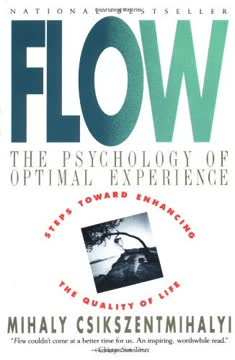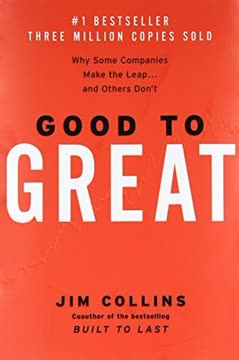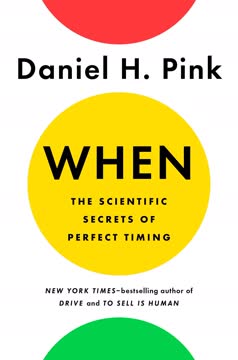Key Takeaways
1. Intrinsic motivation trumps extrinsic rewards for complex tasks
"When money is used as an external reward for some activity, the subjects lose intrinsic interest for the activity."
Carrots and sticks are outdated. Traditional reward systems based on extrinsic motivators (like money or punishments) are ineffective for complex, creative tasks that dominate the modern workplace. Research by Edward Deci and others shows that for tasks requiring cognitive skills, higher rewards led to poorer performance.
Intrinsic motivation is key. People perform better when driven by internal factors such as enjoyment, curiosity, and personal growth. This is especially true for non-routine, conceptual work that requires problem-solving and creativity. Companies like Google and 3M have tapped into this by allowing employees to spend a portion of their time on self-directed projects, leading to innovations like Gmail and Post-it notes.
The Sawyer Effect illustrates this principle. Named after Tom Sawyer's fence-painting trick, it shows how turning work into play can increase motivation and performance. Conversely, adding external rewards to an enjoyable task can make it feel like work, reducing motivation and creativity.
2. Autonomy, mastery, and purpose drive human behavior
"Human beings have an innate inner drive to be autonomous, self-determined, and connected to one another. And when that drive is liberated, people achieve more and live richer lives."
Autonomy fuels engagement. People thrive when they have control over their tasks, time, team, and technique. Companies like Atlassian and Best Buy have implemented "FedEx Days" and Results-Only Work Environments (ROWE), allowing employees to work on self-directed projects or manage their own schedules, resulting in increased productivity and job satisfaction.
Mastery motivates improvement. The desire to get better at something that matters is a powerful driver of human behavior. This explains why people engage in challenging hobbies or pursue difficult career paths without external rewards. Providing opportunities for skill development and growth is crucial for maintaining motivation in the workplace.
Purpose provides direction. Connecting work to a larger cause or meaning enhances motivation and performance. Companies that articulate a clear purpose beyond profit-making tend to have more engaged employees and better long-term success. This is particularly important for younger generations entering the workforce, who prioritize meaningful work over traditional rewards.
3. Traditional management methods stifle creativity and productivity
"Management isn't about walking around and seeing if people are in their offices. It's about creating conditions for people to do their best work."
Command-and-control is obsolete. Traditional management approaches based on close supervision and standardized processes are ill-suited for knowledge work and creative tasks. These methods can reduce autonomy, stifle innovation, and decrease intrinsic motivation.
Empowerment is key. Forward-thinking organizations are shifting towards environments that foster self-direction and creativity. This involves:
- Giving employees more control over their work processes
- Encouraging experimentation and risk-taking
- Providing constructive feedback rather than punitive measures
- Focusing on results rather than face time or rigid schedules
Trust yields better results. When managers trust employees to manage their own time and tasks, it often leads to higher productivity and job satisfaction. Companies like Zappos have implemented self-management systems, allowing teams to organize themselves and make decisions autonomously, resulting in better customer service and employee engagement.
4. "If-then" rewards can backfire and reduce performance
"Rewards can deliver a short-term boost—just as a jolt of caffeine can keep you cranking for a few more hours. But the effect wears off—and, worse, can reduce a person's longer-term motivation to continue the project."
Contingent rewards narrow focus. "If-then" rewards (e.g., "If you do X, then you'll get Y") can be effective for simple, straightforward tasks. However, for complex tasks requiring creativity or problem-solving, they can actually hinder performance by limiting thinking to a narrow, reward-focused path.
Short-term gains, long-term losses. While extrinsic rewards might provide a temporary boost in motivation or performance, they often lead to decreased intrinsic motivation over time. This can result in:
- Reduced creativity and innovation
- Lower quality work once rewards are removed
- Increased likelihood of unethical behavior to achieve rewards
Alternatives to "if-then" rewards. Instead of contingent rewards, organizations can:
- Provide meaningful, non-controlling feedback
- Offer unexpected "now that" rewards after task completion
- Focus on creating an environment that supports autonomy, mastery, and purpose
5. Flow state is essential for peak performance and satisfaction
"The highest, most satisfying experiences in people's lives were when they were in flow."
Flow is optimal experience. Psychologist Mihaly Csikszentmihalyi identified "flow" as a state of deep engagement and enjoyment where people lose track of time and self-consciousness. This state occurs when skills are well-matched to challenges, goals are clear, and feedback is immediate.
Fostering flow in work and life. To promote flow experiences:
- Set clear goals and provide immediate feedback
- Balance challenges with skills (Goldilocks tasks)
- Minimize distractions and interruptions
- Allow for autonomy in task execution
Flow leads to mastery and satisfaction. Regular flow experiences not only enhance performance but also contribute to overall life satisfaction and personal growth. Organizations that create conditions conducive to flow states are likely to see increased productivity, creativity, and employee well-being.
6. Mastery requires embracing challenges and viewing abilities as improvable
"Mastery is a mindset: It requires the capacity to see your abilities not as finite, but as infinitely improvable."
Growth mindset is crucial. Stanford psychologist Carol Dweck's research shows that people with a "growth mindset" (believing abilities can be developed) achieve more than those with a "fixed mindset" (believing abilities are innate and unchangeable). Embracing challenges and viewing failures as learning opportunities are key to developing mastery.
Deliberate practice drives improvement. Achieving mastery requires:
- Setting specific goals for improvement
- Seeking constant, critical feedback
- Focusing on areas of weakness
- Pushing beyond comfort zones
- Persistence in the face of setbacks
Mastery is a journey, not a destination. True mastery is asymptotic – it can be approached but never fully reached. This continuous pursuit provides ongoing motivation and satisfaction, as there's always room for improvement and new challenges to tackle.
7. Purpose-driven work leads to greater fulfillment and success
"The most deeply motivated people—not to mention those who are most productive and satisfied—hitch their desires to a cause larger than themselves."
Purpose maximization alongside profit. Organizations that emphasize purpose alongside profit often see better long-term results. This involves:
- Articulating a clear mission beyond financial gains
- Connecting individual roles to larger organizational goals
- Allowing employees to pursue purpose-driven projects
Personal purpose enhances motivation. Individuals who connect their work to a larger purpose or personal values tend to be more engaged and resilient. This can involve:
- Seeking work aligned with personal values
- Finding ways to make current work more meaningful
- Volunteering or engaging in side projects that provide purpose
Purpose-driven organizations attract talent. Especially among younger generations, companies with a strong sense of purpose are more attractive to potential employees. This can lead to a more engaged workforce and better overall performance.
8. The mismatch between science and business practices hinders progress
"There is a mismatch between what science knows and what business does."
Outdated practices persist. Despite decades of research showing the limitations of carrot-and-stick motivation, many businesses continue to rely on these methods. This mismatch leads to suboptimal performance and decreased employee satisfaction.
Barriers to change include:
- Inertia and resistance to new ideas
- Short-term focus on immediate results
- Misunderstanding of human motivation
- Fear of losing control
Bridging the gap. To align business practices with scientific knowledge:
- Educate leaders on modern motivation research
- Experiment with new management approaches
- Measure long-term outcomes, not just short-term metrics
- Foster a culture of continuous learning and adaptation
9. Type I behavior fosters innovation and long-term success
"Type I behavior is fueled more by intrinsic desires than extrinsic ones. It concerns itself less with the external rewards to which an activity leads and more with the inherent satisfaction of the activity itself."
Type I vs. Type X behavior. Type I (intrinsically motivated) individuals tend to be more creative, productive, and satisfied than Type X (extrinsically motivated) individuals. Organizations that foster Type I behavior are more likely to innovate and succeed in the long term.
Cultivating Type I behavior:
- Provide autonomy over tasks, time, team, and technique
- Offer opportunities for skill development and mastery
- Connect work to a larger purpose or meaning
- Use "now that" rewards instead of "if-then" rewards
- Encourage experimentation and learning from failures
Type I behavior is self-reinforcing. As individuals experience the benefits of intrinsic motivation, they're more likely to seek out and create environments that support it. This can lead to a virtuous cycle of increased engagement, creativity, and success.
Last updated:
FAQ
What's "Drive: The Surprising Truth About What Motivates Us" about?
- Core Premise: The book explores the science of motivation, challenging traditional views that rely on external rewards and punishments.
- Three Elements: It introduces a new framework for motivation based on autonomy, mastery, and purpose.
- Historical Context: The book traces the evolution of motivational theories from basic survival instincts to complex intrinsic motivations.
- Practical Application: It provides insights into how these motivational principles can be applied in business, education, and personal development.
Why should I read "Drive: The Surprising Truth About What Motivates Us"?
- Scientific Insights: The book is grounded in decades of research in psychology and behavioral science, offering evidence-based insights.
- Practical Advice: It provides actionable strategies for enhancing motivation in various settings, from workplaces to schools.
- Challenging Norms: It questions conventional wisdom about motivation, encouraging readers to rethink how they approach tasks and goals.
- Broader Impact: Understanding these principles can lead to more fulfilling personal and professional lives.
What are the key takeaways of "Drive: The Surprising Truth About What Motivates Us"?
- Intrinsic Motivation: True motivation comes from within, driven by autonomy, mastery, and purpose rather than external rewards.
- Autonomy: People perform better when they have control over their tasks, time, techniques, and team.
- Mastery: The pursuit of becoming better at something that matters is a key driver of motivation.
- Purpose: Connecting work to a larger cause enhances motivation and satisfaction.
How does Daniel H. Pink define "Type I" and "Type X" behavior?
- Type I Behavior: Driven by intrinsic motivations, focusing on the inherent satisfaction of the activity itself.
- Type X Behavior: Driven by extrinsic rewards, focusing on the external outcomes of the activity.
- Long-term Success: Type I behavior leads to greater long-term success and personal fulfillment.
- Adaptability: Type I behavior can be cultivated, regardless of one's starting point.
What is the "Sawyer Effect" as described in "Drive"?
- Concept Origin: Named after Tom Sawyer, it describes how rewards can turn play into work.
- Negative Aspect: External rewards can diminish intrinsic motivation and make enjoyable tasks feel like chores.
- Positive Aspect: Conversely, focusing on mastery can transform work into play, enhancing engagement.
- Application: Understanding this effect can help design better motivational strategies in various settings.
How does "Drive" suggest we should approach compensation and rewards?
- Baseline Rewards: Ensure fair and adequate compensation to take money off the table as a motivator.
- Noncontingent Rewards: Use "now that" rewards, which are unexpected and given after task completion, to avoid undermining intrinsic motivation.
- Fairness and Transparency: Compensation should be internally and externally fair to prevent demotivation.
- Focus on Work: The goal is to allow individuals to focus on the work itself rather than the financial incentives.
What role does "autonomy" play in motivation according to "Drive"?
- Core Element: Autonomy is essential for fostering intrinsic motivation and engagement.
- Four Aspects: It includes autonomy over task, time, technique, and team.
- Impact on Performance: Autonomy leads to higher job satisfaction and better performance.
- Organizational Examples: Companies that embrace autonomy, like Google and Atlassian, often see increased innovation and productivity.
How does "Drive" explain the concept of "mastery"?
- Continuous Improvement: Mastery involves the desire to get better at something that matters.
- Flow State: Achieving mastery often involves reaching a state of flow, where challenges match one's abilities.
- Effort and Grit: Mastery requires sustained effort and perseverance over time.
- Asymptote of Mastery: Full mastery is never fully attainable, making the pursuit both challenging and rewarding.
What is the "purpose motive" in "Drive"?
- Beyond Profit: Purpose involves doing something that serves a greater cause beyond oneself.
- Organizational Shift: Companies are increasingly recognizing the importance of purpose alongside profit.
- Individual Fulfillment: Purpose-driven individuals report higher satisfaction and well-being.
- Generational Influence: Both baby boomers and millennials are driving the shift towards purpose in work and life.
What are some practical strategies from "Drive" for fostering motivation?
- FedEx Days: Encourage innovation by allowing employees to work on any project they choose for a day.
- 20 Percent Time: Allocate a portion of work time for employees to pursue their own projects.
- Autonomy Audits: Assess and increase the level of autonomy in your organization.
- DIY Report Cards: Encourage self-assessment and personal goal setting to enhance mastery.
What are the best quotes from "Drive" and what do they mean?
- "The secret to high performance isn't our biological drive or our reward-and-punishment drive, but our third drive—our deep-seated desire to direct our own lives, to extend and expand our abilities, and to live a life of purpose." This quote encapsulates the book's central thesis that intrinsic motivation is key to achieving high performance.
- "Control leads to compliance; autonomy leads to engagement." This highlights the importance of autonomy in fostering genuine engagement and motivation.
- "Mastery is an asymptote." This metaphor suggests that while mastery is never fully attainable, the pursuit itself is what drives us forward.
- "Purpose provides activation energy for living." This emphasizes the role of purpose in energizing and motivating individuals.
How can "Drive" be applied in educational settings?
- Intrinsic Motivation: Focus on fostering students' intrinsic motivation rather than relying on grades and rewards.
- Autonomy in Learning: Allow students to have a say in their learning process and encourage self-directed projects.
- Mastery-Oriented Tasks: Design assignments that challenge students appropriately and promote mastery.
- Purposeful Education: Help students connect their learning to real-world applications and larger goals.
Review Summary
Drive received mostly positive reviews for its exploration of intrinsic motivation. Readers found the book insightful, offering a fresh perspective on what drives people beyond traditional rewards. Many appreciated Pink's clear writing style and practical examples. Some critics felt the ideas were repetitive or not entirely original. The book's core message, emphasizing autonomy, mastery, and purpose as key motivators, resonated with many readers across various fields, including business, education, and personal development.
Similar Books










Download PDF
Download EPUB
.epub digital book format is ideal for reading ebooks on phones, tablets, and e-readers.








